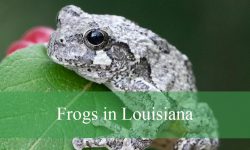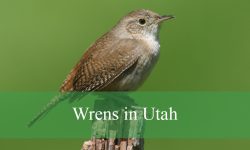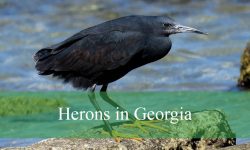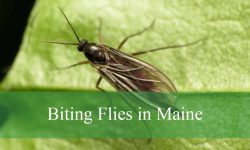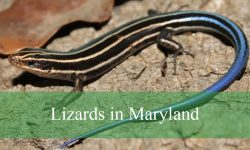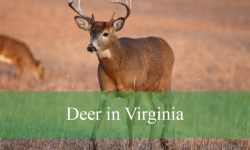Squirrels in California are found in a wide range of environments, from dense mountain forests to dry deserts and busy urban parks. Each species has unique traits that make it well-suited to its habitat, offering plenty to observe for those who enjoy wildlife.
Some squirrels glide silently through the treetops at night, while others scurry across open ground in search of seeds and shelter. Their behaviors, colors, and sizes vary widely, making them fascinating to identify and compare.
This guide highlights 9 common squirrels in California, complete with pictures and key identification details. It’s designed to help you recognize each species and understand where they live and how they behave across the state.
Common Squirrels Found in California
Western Gray Squirrel (Sciurus griseus)
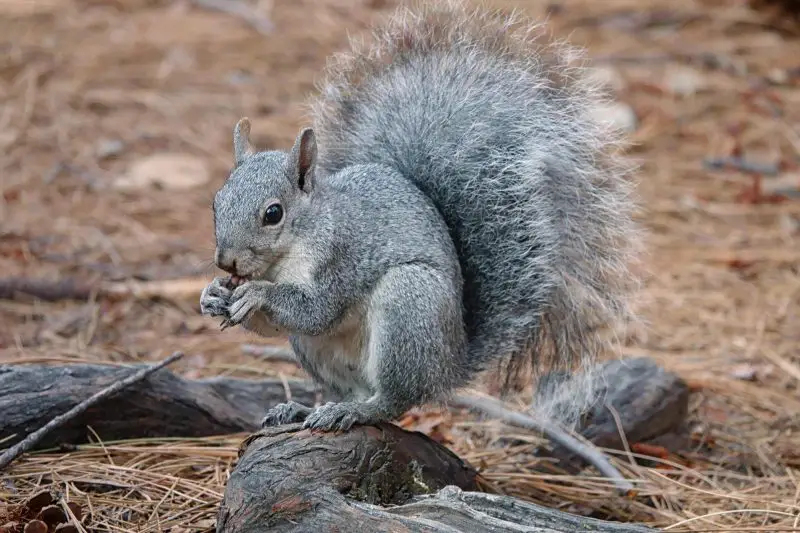
The Western Gray Squirrel is a striking native species known for its elegant appearance and elusive nature. This tree squirrel features a silvery-gray coat on its back, which contrasts with a pure white underbelly. Its most noticeable feature is the long, full tail that is heavily furred and often held in a graceful curve over the back. Adults typically measure around 18 to 24 inches in total length, including their bushy tail, and can weigh between 400 to 850 grams.
This squirrel is most often spotted in tall trees, especially within oak woodlands and mixed coniferous forests. It prefers quiet, less disturbed areas and is far less likely to be found in urban environments than some other squirrel species. Western Gray Squirrels are diurnal, meaning they are active during the daytime. They are excellent climbers and spend most of their lives in the tree canopy, only occasionally descending to the ground to forage or move between trees.
Their diet consists primarily of acorns, pine seeds, fungi, and a variety of fruits and nuts depending on seasonal availability. They play an essential role in forest ecology by dispersing seeds and spores. During autumn, they often gather and cache food to survive the winter months, though they do not hibernate and remain active year-round. Their large cheek pouches allow them to transport multiple items of food to storage sites.
In California, the Western Gray Squirrel is widespread across central and northern parts of the state, especially in the Sierra Nevada foothills, the coastal ranges, and certain parts of the Central Valley. Their populations can be locally abundant in protected forested areas, although they are sensitive to habitat fragmentation and loss, which has affected their range in some places.
Eastern Fox Squirrel (Sciurus niger)
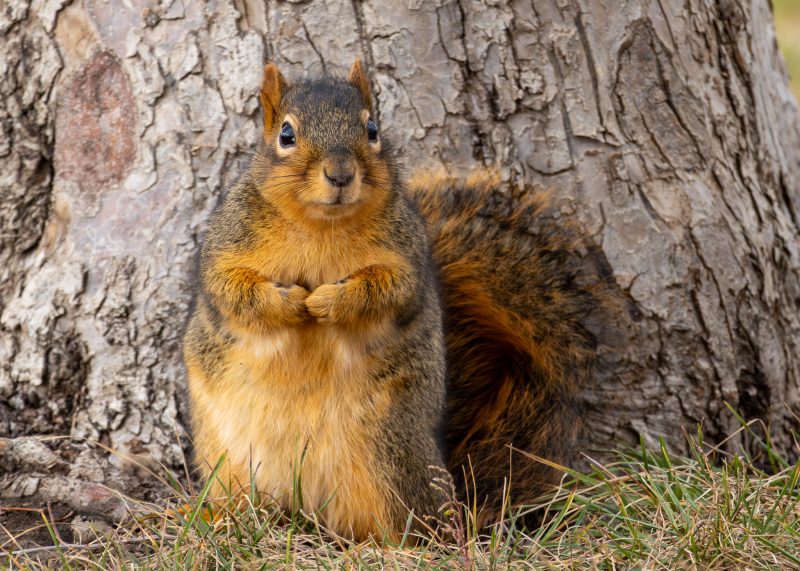
The Eastern Fox Squirrel is the largest tree squirrel in North America and is immediately recognizable by its size and coloration. It has a reddish-brown to rusty-orange back, with buff or orange-colored underparts and a long, thick tail edged with darker and lighter hairs. Adult fox squirrels can grow up to 27 inches in total length, with weights ranging from 500 to 1,000 grams. Its robust build and bold behavior distinguish it from native California squirrels.
Originally native to the eastern and central United States, this species was introduced to California in the early 1900s, likely through urban park plantings and tree exports. Since then, it has flourished in various habitats, especially those altered or managed by humans. It is now a common sight in city parks, residential neighborhoods, farmlands, and even golf courses throughout southern and central California.
Highly adaptable, fox squirrels are opportunistic feeders that consume a wide variety of foods, including nuts, seeds, flowers, fruits, insects, and bird eggs. In urban environments, they often forage in trash bins or accept handouts from people. During the fall, they store acorns and other nuts in scattered caches, returning later to retrieve them. Their keen sense of smell helps them relocate these food stores even months later.
In California, the Eastern Fox Squirrel is prevalent in the Central Valley, Los Angeles Basin, and parts of the San Francisco Bay Area. Their range is still expanding, sometimes overlapping with that of the native Western Gray Squirrel, with whom they may compete for food and nesting areas. However, due to their adaptability and reproductive success, fox squirrels are unlikely to decline in the near future.
Eastern Gray Squirrel (Sciurus carolinensis)
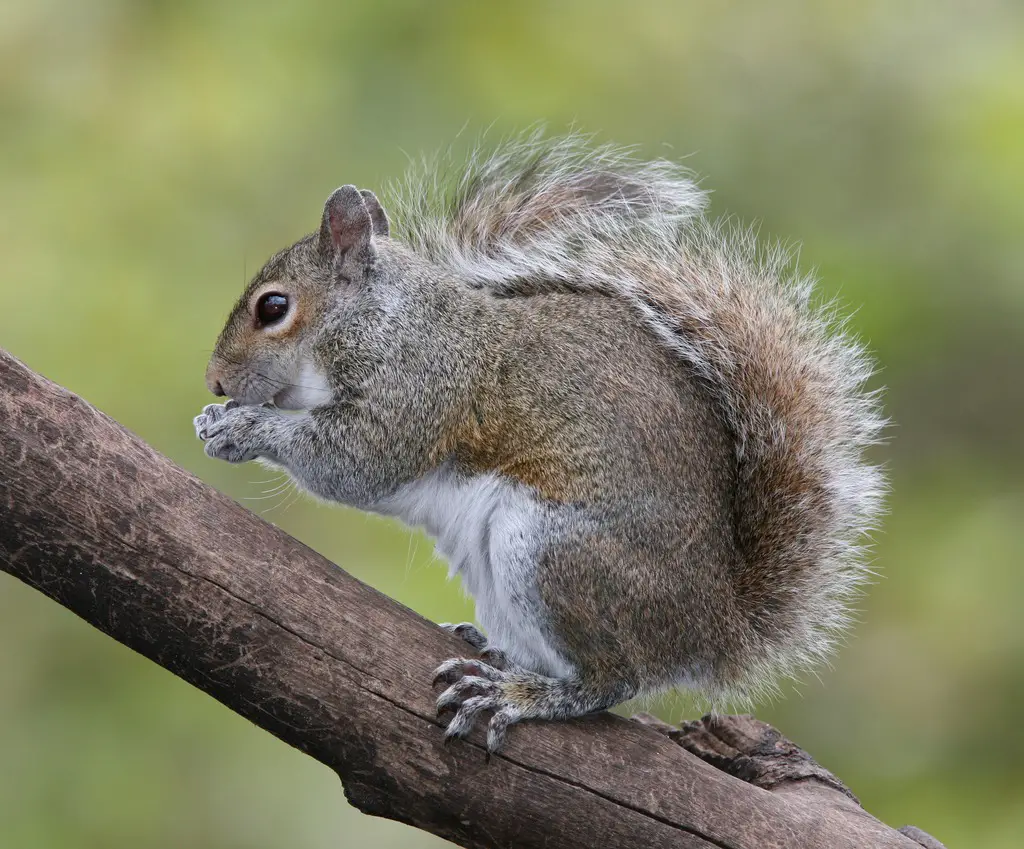
The Eastern Gray Squirrel is another non-native species that has become well established in parts of California. It has soft gray fur on its back and flanks, with a white to light gray underbelly. Its large, bushy tail, typically fringed with white hairs, helps with balance and warmth. Smaller than the fox squirrel, adult Eastern Gray Squirrels measure about 16 to 20 inches in length and weigh between 400 to 600 grams.
Originally from the eastern United States, this species was introduced to California in the early to mid-20th century and has since spread into urban and suburban areas, particularly in northern parts of the state. It thrives in city parks, college campuses, gardens, and wooded residential neighborhoods. Unlike the Western Gray Squirrel, which avoids human activity, the Eastern Gray Squirrel is bold and curious, often seen scavenging near people.
Its diet is varied and includes nuts, seeds, fruits, buds, flowers, mushrooms, and even bird eggs or nestlings when food is scarce. Like other tree squirrels, it is known for its caching behavior—burying food for future use. It’s also highly agile and spends a great deal of time leaping between branches, building leafy nests called dreys high in trees for shelter and rearing young.
In California, Eastern Gray Squirrels are especially common in San Francisco, Sacramento, and other urban centers in the north. They tend to outcompete native squirrels for food and nesting sites, which has raised ecological concerns. Because of their adaptability, intelligence, and tolerance for human presence, they have become one of the most recognizable and widespread squirrel species in developed areas.
Douglas Squirrel (Tamiasciurus douglasii)
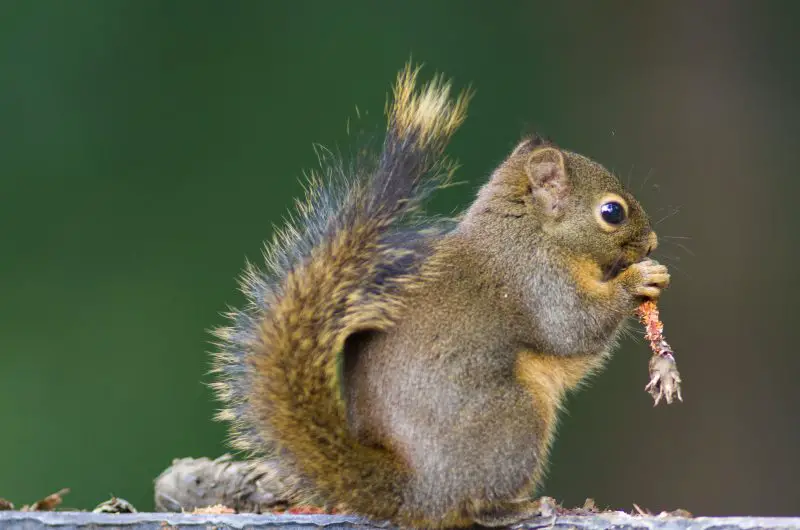
The Douglas Squirrel, also known as the chickaree, is a small, spirited native species found in the forests of California’s mountains and coastal regions. It has a rich reddish-brown to rust-colored coat on its back, contrasted by a pale orange or white belly. During winter, its fur darkens slightly and it grows ear tufts, giving it a distinctive seasonal appearance. Adults typically reach 10 to 14 inches in total length and weigh around 150 to 300 grams.
This squirrel is most at home in coniferous forests, particularly among pine, fir, and cedar trees. It is native to the Sierra Nevada, Cascade Range, and coastal mountain forests in northern California. Known for its bold and energetic demeanor, the Douglas Squirrel is extremely vocal. It emits a rapid chattering or squeaky alarm call when disturbed, which has become a familiar sound in its woodland habitat.
The Douglas Squirrel’s diet centers on seeds from conifer cones, which it strips and piles in cone scale middens near feeding areas. It also eats mushrooms, berries, insects, and occasionally bird eggs. Unlike some squirrels, it does not hibernate, staying active throughout the year. It creates multiple nests—usually in tree cavities or dense foliage—and is highly territorial, defending its home range aggressively against intruders.
In California, this species is primarily found in the northern and eastern mountainous regions, especially at elevations from 1,000 to 10,000 feet. It prefers mature forests with closed canopies and an abundance of cone-producing trees. While its populations are stable in many areas, they can be sensitive to logging and changes in forest composition, which affect their food sources and nesting sites.
Northern Flying Squirrel (Glaucomys sabrinus)
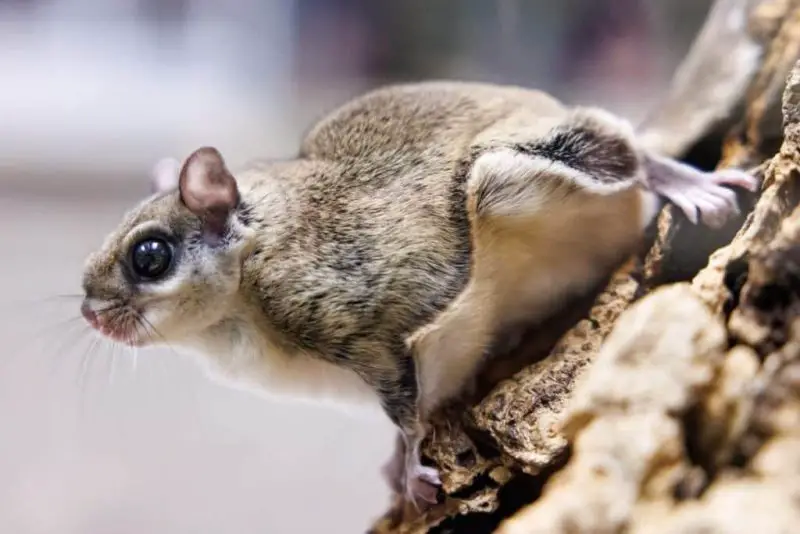
The Northern Flying Squirrel is a nocturnal marvel of the forest, rarely seen by casual observers due to its nighttime activity and arboreal lifestyle. It has thick, soft brown fur with a pale belly and a flat, wide tail that helps with gliding. The most distinctive feature of this species is the patagium—a fur-covered membrane of skin that stretches from the wrist to the ankle, allowing the squirrel to glide through the air. Large, forward-facing black eyes enhance its vision in low-light environments.
Primarily active at night, these squirrels emerge after sunset to forage, using their excellent climbing skills to navigate the forest canopy. Rather than leaping from branch to branch, they glide between trees—sometimes covering distances of over 100 feet—to escape predators or reach food sources. During the day, they rest in tree cavities, old woodpecker holes, or nests lined with moss and shredded bark. They are social animals, often sharing winter dens to conserve heat.
Their diet includes fungi (especially truffles), lichens, seeds, nuts, berries, and occasionally insects or bird eggs. They play an important ecological role in spreading fungal spores that help trees absorb nutrients. Unlike some squirrels, Northern Flying Squirrels do not hibernate but may reduce activity during the coldest periods of winter, especially at high elevations.
In California, the Northern Flying Squirrel inhabits dense coniferous forests in the northern part of the state and throughout the Sierra Nevada. They prefer moist, mature woodlands with an abundance of tree cover and cavities. Their elusive nature and specific habitat needs make them difficult to study, but they are considered important indicators of forest health.
California Ground Squirrel (Otospermophilus beecheyi)
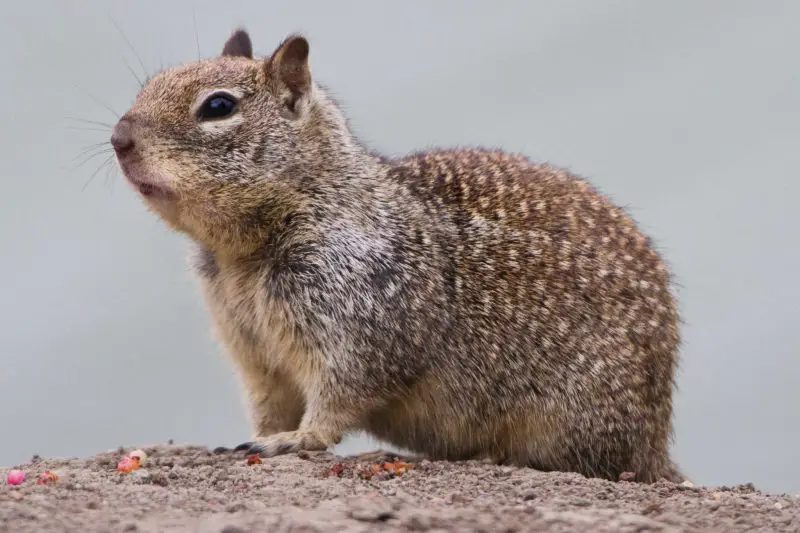
The California Ground Squirrel is one of the most common and recognizable squirrel species in the state. It has mottled gray and brown fur, often with lighter spots on the back and a creamy underside. Its bushy tail is less pronounced than that of tree squirrels but still quite full. Adults typically measure 16 to 20 inches long, including the tail, and weigh around 400 to 800 grams. They are stout, alert, and often seen standing upright at the entrance of their burrows.
These squirrels are diurnal and spend much of their time above ground during the warmer parts of the day. They dig extensive burrow systems used for sleeping, food storage, and raising young. In areas with colder winters, they enter a state of hibernation for several months, while in milder coastal regions, they remain active year-round. They are known to form loose colonies, although each squirrel maintains its own burrow.
California Ground Squirrels are omnivores, feeding mainly on seeds, nuts, green vegetation, and fruits, but they will also eat insects, bird eggs, and even small vertebrates if the opportunity arises. They often sit upright while eating and are known for their alertness, quickly retreating to burrows at the sign of danger. They also display a tail-flicking and vocalizing behavior to deter predators such as snakes.
This species is found throughout most of California, from coastal cliffs to inland valleys and foothills. They thrive in open grasslands, chaparral, and agricultural areas and are highly adaptable to human-altered landscapes. In some places, they are considered agricultural pests due to their burrowing behavior and crop damage, but they are also important prey for raptors and carnivores.
Belding’s Ground Squirrel (Urocitellus beldingi)
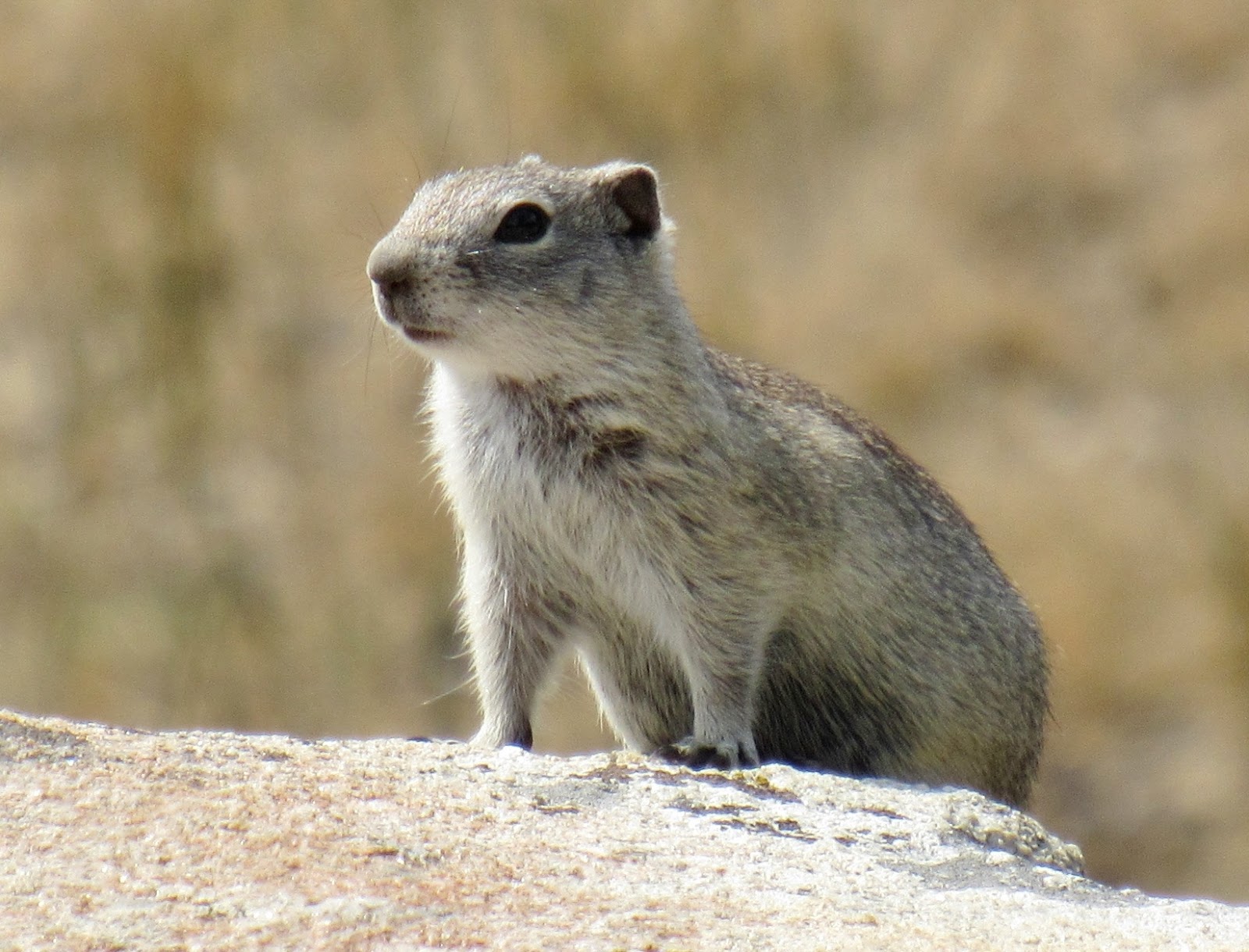
Belding’s Ground Squirrel is a high-elevation species native to California’s eastern Sierra Nevada and the Great Basin region. It has a compact body with grayish fur, sometimes tinged with cinnamon, and a short, flattened tail. The face is often marked with a slightly lighter or reddish tint, and the overall body length ranges from 9 to 12 inches. Their shorter tail and uniform coloring help differentiate them from other ground squirrels in the region.
This squirrel species is highly adapted to life in alpine meadows, sagebrush flats, and subalpine grasslands. They are active only during the warmer months, emerging from hibernation in late spring and returning to their burrows by early fall. Belding’s Ground Squirrels are most frequently seen from May through August, when they forage intensively to build up fat reserves for their long hibernation period, which can last 8 to 9 months.
Their diet is composed of grasses, forbs, seeds, and the occasional insect. They are important seed dispersers in their alpine ecosystems and provide a key food source for predators such as hawks, coyotes, and weasels. They often forage in open spaces near burrow entrances and emit high-pitched alarm calls to warn others of danger. Socially, they live in colonies, although interactions are limited outside of breeding season.
In California, Belding’s Ground Squirrels are primarily found at elevations between 5,000 and 11,000 feet in the eastern Sierra Nevada, northern Mono County, and parts of the Modoc Plateau. Their restricted range and specific habitat requirements make them vulnerable to habitat loss from climate change and human recreation, particularly in heavily used mountain meadows.
Merriam’s Ground Squirrel (Urocitellus canus)
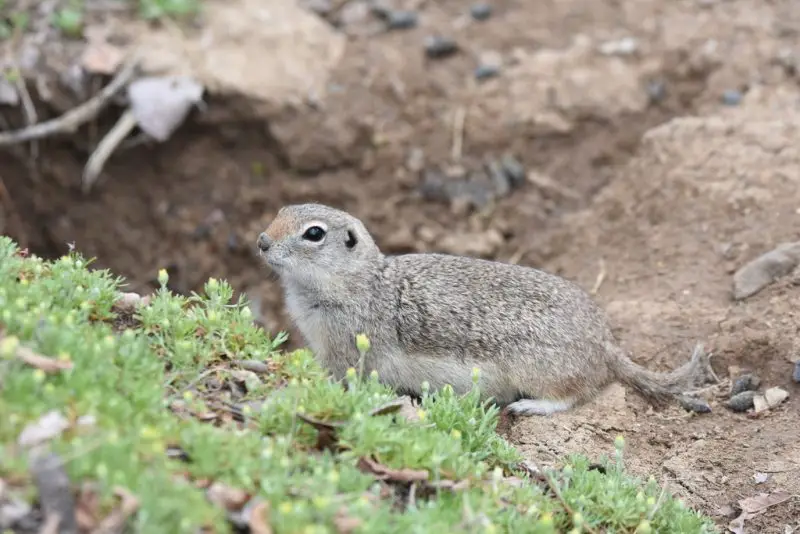
Merriam’s Ground Squirrel is a small, secretive rodent found in the arid landscapes of southeastern California. It has a pale tan or buff-colored coat with minimal markings, a short tail, and a slender body. Adults are small—typically between 7 and 10 inches long—and their understated appearance helps them blend seamlessly into sandy or gravelly desert environments.
Unlike more conspicuous squirrels, Merriam’s Ground Squirrel is elusive and rarely seen. It spends a large portion of the day in its burrow to avoid the intense desert heat and only emerges briefly to forage during the cooler hours of morning and late afternoon. Their behavior is solitary, and they do not form large colonies like some other ground squirrels. They are fast and wary, disappearing quickly at the slightest threat.
This squirrel feeds on a diet of seeds, grasses, green shoots, and desert wildflowers. It may occasionally consume insects, particularly when moisture is scarce. The species enters a summer estivation or winter hibernation, depending on the severity of seasonal conditions, reducing its metabolic activity to conserve water and energy.
In California, Merriam’s Ground Squirrel is found in the Mojave Desert, parts of the Colorado Desert, and other semi-arid or desert fringe habitats in the southeastern part of the state. Its distribution includes areas near Joshua Tree National Park and the edges of the Salton Sea. Because of its quiet habits and preference for low-profile terrain, it is often overlooked in surveys, although it remains a vital part of desert ecosystems.
Rock Squirrel (Otospermophilus variegatus)
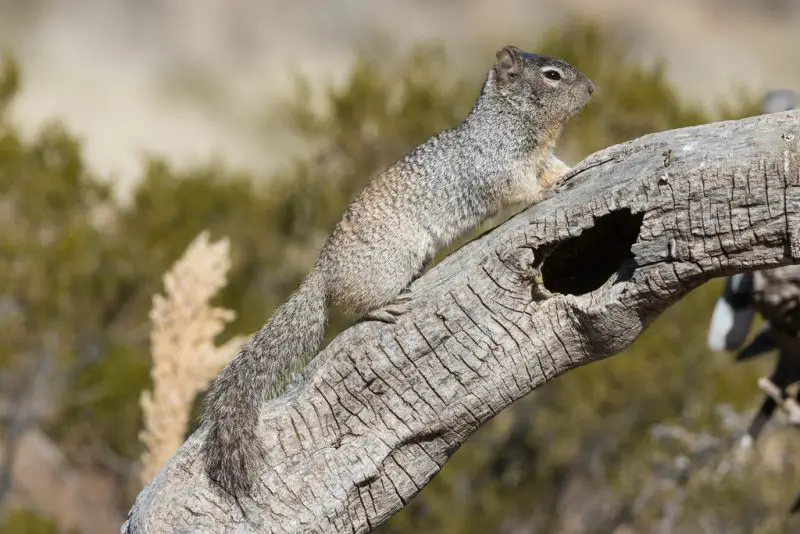
The Rock Squirrel is one of the largest ground squirrels in the western United States and has recently expanded its range into southeastern California. It has a coarse, speckled coat of gray and brown with a lighter underbelly, and a long, semi-bushy tail. Adults can reach up to 21 inches in total length and weigh as much as 1,000 grams. Their large size and bold behavior make them stand out in desert and canyon landscapes.
True to their name, Rock Squirrels are closely associated with rocky habitats, desert outcrops, cliffs, and canyons. They dig burrows under boulders or in crevices and are adept climbers, occasionally ascending trees or shrubs in search of food. Although primarily ground-dwelling, they are very agile and spend considerable time sunning themselves on rocks or surveying their surroundings from elevated perches.
They are omnivorous and opportunistic, feeding on seeds, nuts, fruits, green vegetation, insects, small vertebrates, and even carrion. Rock Squirrels are active during the warmer months and may enter short periods of torpor during extreme heat or cold. Their diet and foraging range vary widely depending on local resources, and they are known to raid human campsites or gardens when available.
In California, they are mostly limited to the southeastern deserts, particularly near the Arizona border and regions like the Mojave Desert, Anza-Borrego, and areas around the lower Colorado River. Their ability to thrive in arid, rocky environments with limited vegetation gives them an advantage in desert ecosystems, where few other squirrels can survive year-round.
Best Time and Places to See Squirrels in California
California’s varied ecosystems—ranging from coastal woodlands to mountain forests and arid deserts—offer rich habitats for many squirrel species. The ideal time to see squirrels is typically during the early morning or late afternoon hours, when they are most active. This is especially true in spring and fall, as squirrels forage heavily in preparation for breeding or winter food storage.
During spring, tree squirrels such as the Western Gray Squirrel and Douglas Squirrel are particularly visible as they gather food, build nests, and care for their young. Summer remains a good time for observation, though squirrels may become less active during the midday heat. In fall, activity increases again as squirrels begin caching food. Winter viewing depends on the species and location. Tree squirrels remain active throughout the colder months, while ground squirrels often hibernate or enter a state of torpor in higher elevations or northern parts of the state.
The best places to see squirrels in California depend on the species and habitat. Yosemite National Park and the Sierra Nevada offer excellent opportunities to observe Douglas Squirrels and Belding’s Ground Squirrels in their natural coniferous and alpine meadow habitats. The Northern Flying Squirrel, though rarely seen, also inhabits these forests and may be detected with night cameras or red-filtered flashlights around mature trees.
In northern California, redwood forests and places like Lassen National Park provide suitable environments for the Western Gray Squirrel and Northern Flying Squirrel. These areas, rich in tall evergreens and tree cavities, are ideal for spotting tree-dwelling species, especially in quieter zones away from heavy tourist activity.
Coastal regions like Point Reyes National Seashore and Big Sur feature oak woodlands and open fields where Western Gray Squirrels and California Ground Squirrels thrive. Urban parks such as San Francisco’s Golden Gate Park, Los Angeles’ Griffith Park, and San Diego’s Balboa Park are among the best places to see Eastern Gray Squirrels and Eastern Fox Squirrels, which have adapted well to human environments and are often seen near trails, benches, and picnic areas.
In California’s southeastern deserts, such as Joshua Tree National Park and Anza-Borrego Desert State Park, Merriam’s Ground Squirrel and Rock Squirrel inhabit rocky hillsides and scrubland. Early morning is the best time to spot them, as they avoid extreme midday heat. Meanwhile, the Central Valley’s agricultural landscapes and grassy foothills are home to large populations of California Ground Squirrels, commonly seen perched near their burrows or scurrying across open fields.
Overall, the best time to see squirrels in California is during the early hours or before dusk in spring or fall, with viewing opportunities ranging from mountain forests and coastal parks to arid deserts and city green spaces.

